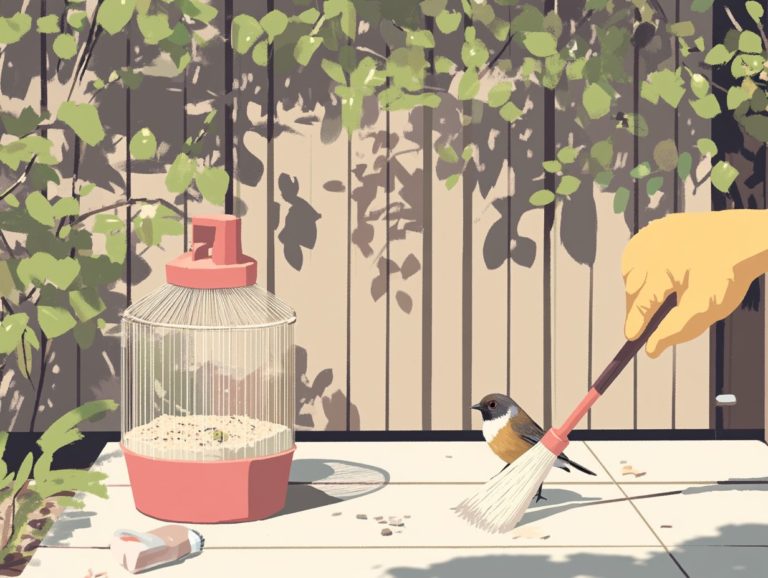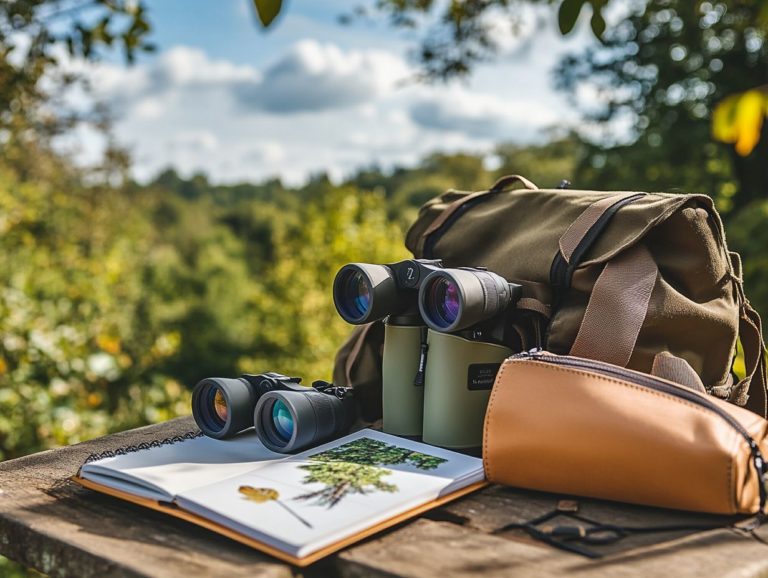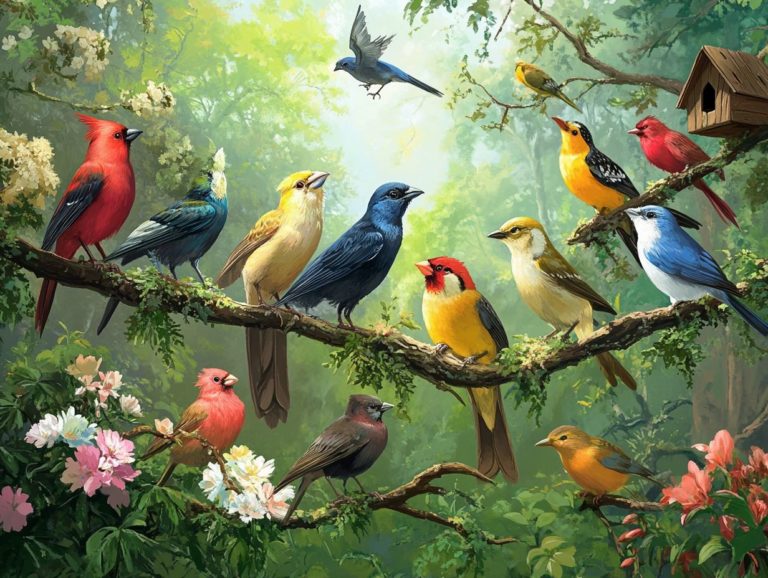How Often Should I Clean My Bird Feeder?
Keeping your bird feeder clean is crucial for the health and well-being of your feathered friends. Neglecting this task can pose significant health risks. Familiarize yourself with proper cleaning techniques to keep your birds safe.
Several factors dictate how frequently you should clean your feeder, including its location, type, and weather conditions. Discover how you can easily keep your bird feeder clean and safe with a recommended cleaning schedule, step-by-step instructions, and invaluable tips for preventing mold and bacteria growth.
Learn how to attract the right species while creating a clean and inviting environment for them.
Contents
- Key Takeaways:
- The Importance of Cleaning Your Bird Feeder
- Cleaning Frequency: Factors to Consider
- Recommended Cleaning Schedule
- How to Properly Clean Your Bird Feeder
- Tips for Maintaining a Clean Feeder
- Frequently Asked Questions
- How Often Should I Clean My Bird Feeder?
- Why is it important to clean my bird feeder regularly?
- What happens if I don’t clean my bird feeder often enough?
- Can I clean my bird feeder too often?
- How should I clean my bird feeder?
- Are there any specific parts of the bird feeder that need extra attention when cleaning?
Key Takeaways:
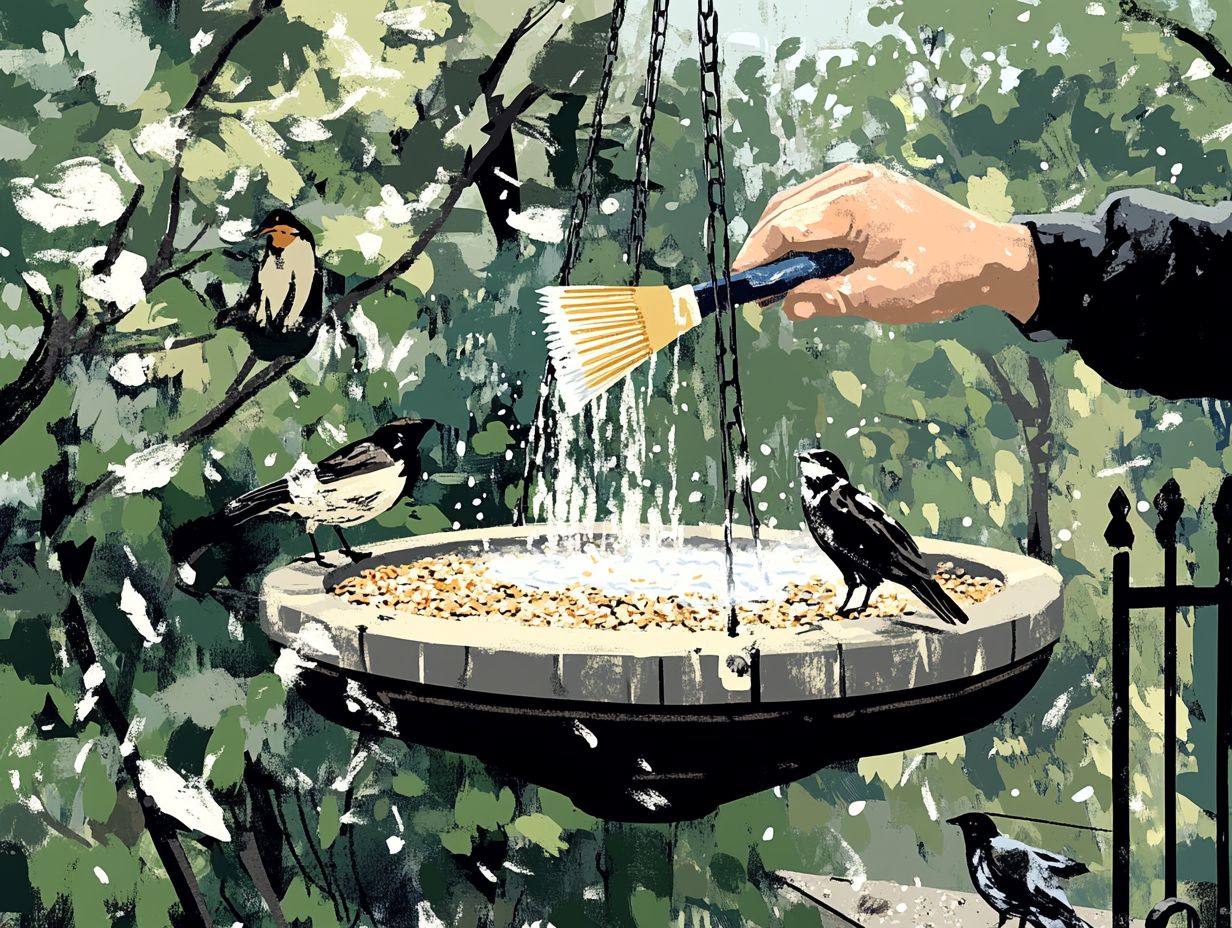
- Clean your bird feeder regularly to ensure bird safety, as dirty feeders can harbor harmful bacteria and mold.
- Determine the frequency of cleaning your bird feeder based on its location, type, and weather conditions.
- Make it a priority to clean your bird feeder every 1-2 weeks, using a bleach solution and scrubbing well. Dry the feeder thoroughly and use fresh food to prevent mold and bacteria growth.
The Importance of Cleaning Your Bird Feeder
Cleaning your bird feeder is essential for the health of the avian visitors in your backyard. A dirty feeder can harbor harmful bacteria, leading to disease outbreaks that negatively affect bird health.
Regular cleaning keeps these birds healthy and enhances your wildlife photography opportunities by attracting a diverse array of species. By prioritizing the care of your bird feeder and implementing effective disease prevention strategies, you create a safe and inviting haven for your feathered friends.
Potential Health Risks for Birds
Birds face various health risks when feeders aren t kept clean, including avian flu, salmonellosis, and mycoplasmal conjunctivitis. These conditions can spread quickly among flocks and lead to alarming mortality rates.
These diseases often hitch a ride on contaminated seeds, water, and droppings that accumulate in neglected feeders. When birds show symptoms like lethargy, loss of appetite, respiratory distress, or swollen eyes, it signals a significant health decline.
Regularly cleaning your feeders not only eliminates harmful residues but also significantly reduces the risk of disease outbreaks, ensuring the well-being of local bird populations. Neglecting this vital task allows harmful bacteria and viruses to flourish, posing serious threats to wildlife conservation efforts and biodiversity.
Taking a proactive approach to feeder maintenance is essential for fostering healthier birds and nurturing a thriving ecosystem.
Cleaning Frequency: Factors to Consider
The frequency with which you clean your bird feeders is shaped by several considerations. These include the type of feeder, the number of feathered visitors, and specific maintenance recommendations from experts to ensure the best health for your avian friends.
Location and Type of Feeder
The location and type of feeder you select are pivotal in determining how often it needs cleaning. Some feeders may attract more outdoor pests and rodent activity, meaning you ll need to maintain them more frequently.
For example, tube feeders, typically hung from trees or hooks, are generally easy to clean due to their straightforward design. However, if placed in secluded areas, they may become magnets for squirrels and other critters.
On the flip side, seed buffets, which offer wide access points for birds, often require more diligent upkeep since spilled seeds can attract unwanted guests.
Copper feeders might be a visual delight, but their crevices can easily accumulate dirt and debris, prompting you to give them regular attention to prevent creating a cozy spot for rodents.
Ultimately, implementing effective rodent prevention strategies and maintaining your feeders keeps them clean and fosters a safer environment for your feathered friends.
Start cleaning your bird feeder today and watch your backyard come alive with vibrant avian visitors!
Weather Conditions
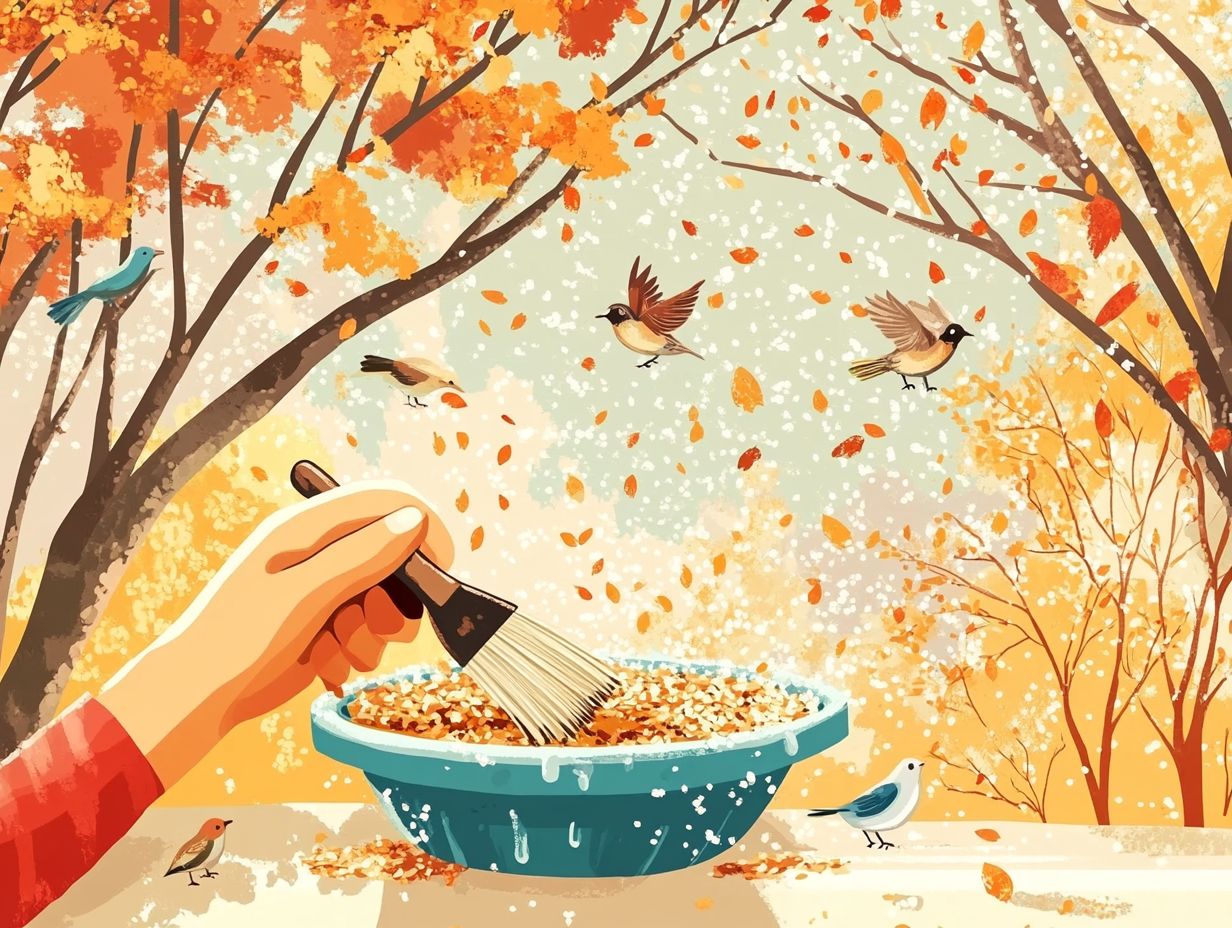
Weather conditions play an important role in determining your bird feeders’ cleaning schedule. Rain, snow, and humidity can accelerate mold and bacteria growth, which jeopardizes the health and safety of your feathered visitors.
As a bird enthusiast, you’ll love keeping your feeders clean! It’s important to routinely inspect your feeders, especially after significant weather changes. For instance, during heavy rainfall, water can infiltrate feed containers, resulting in soggy food that attracts unwanted pests.
Regular checks become even more critical in winter when snow and ice may obscure feeders or freeze food, creating an unsanitary environment. Consider using feeder covers or positioning them in sheltered spots to minimize direct exposure to precipitation. Adjusting your cleaning frequency according to seasonal variations will help you maintain a safe feeding station for your avian companions.
In spring and summer, more frequent cleaning may be necessary due to higher humidity levels. In winter, inspections every few weeks might suffice, depending on snowfall and temperature changes.
Recommended Cleaning Schedule
Establishing a recommended cleaning schedule for your bird feeders is essential to maintaining a safe and inviting environment for your feathered visitors. For detailed instructions, check out how to clean your bird feeder properly. Guidelines suggest a thorough cleaning at least once every two weeks, or even more frequently during peak feeding times.
This proactive approach not only enhances your feeders’ allure but also promotes the health and well-being of the birds that rely on them.
General Guidelines
To maintain pristine bird feeders, adopt a thorough cleaning routine that emphasizes food hygiene practices. This includes properly storing seed and routinely replacing sugar water or other fresh food.
- Start by gathering your cleaning essentials: warm soapy water, vinegar, or a specialized bird feeder cleaning solution.
- First, take down the feeder and empty its contents, ensuring you discard any old seeds or remnants.
- Then, scrub all surfaces with your chosen cleaning solution to eliminate mold, bacteria, or pests. Don t forget to focus on those tiny crevices where grime loves to hide.
- After scrubbing, rinse everything thoroughly and allow the feeder to dry completely before refilling it with fresh feed.
Investing in seed storage containers and conducting regular checks on the feeder’s condition will help you monitor its cleanliness. This proactive approach significantly reduces the risk of contamination, ultimately benefiting the health of the birds visiting your garden.
How to Properly Clean Your Bird Feeder
To effectively clean your bird feeder, it s essential to follow a carefully curated set of steps. This meticulous process ensures that the feeder is thoroughly cleaned and disinfected, eliminating harmful bacteria and creating a safe feeding environment for the delightful birds in your backyard.
Step-by-Step Instructions
Following these step-by-step instructions will guide you in effectively cleaning your bird feeder, ensuring it remains free from harmful bacteria and safe for your avian visitors.
- Begin by completely disassembling the feeder, removing any old seeds and debris that may have accumulated in tricky spots. As you take apart the components, keep an eye on how they fit together for smooth reassembly later.
- Next, prepare a solution of warm water mixed with mild soap or vinegar. Soak the parts for about 15-20 minutes to allow any buildup to loosen. For stubborn spots, a soft brush or an old toothbrush will do wonders in scrubbing away the grime.
- After thoroughly rinsing to eliminate any soap residue, dry all components with a clean cloth, ensuring that no moisture lingers. As you get ready to reassemble the feeder, consider placing it in a sunny spot to speed up the drying process.
Keeping the area around the feeder tidy and using fresh seeds will help create an inviting atmosphere for healthy birds in the long run.
Tips for Maintaining a Clean Feeder
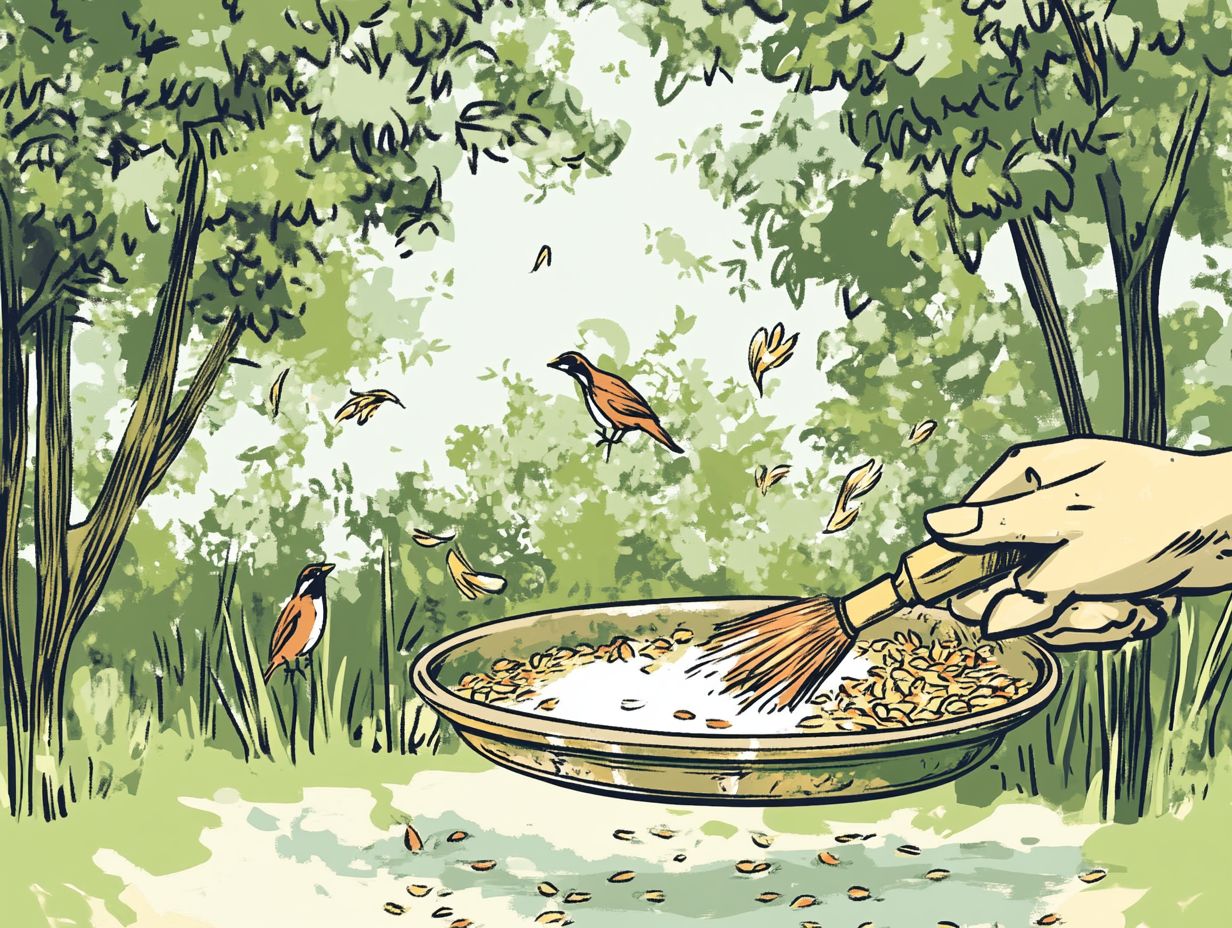
To maintain a pristine bird feeder and attract the right birds, it s crucial to adopt practices that prevent the growth of mold and bacteria.
Ensure your feeder is always stocked with supplies that meet the needs of your feathered friends.
Preventing Mold and Bacteria Growth
Preventing mold and bacteria growth in your bird feeder requires you to keep your feeder clean. Regularly cleaning and restocking your feeders with fresh food is essential.
Using dry seeds helps reduce moisture-related issues, ensuring the food remains safe for your birds. Checking the moisture levels within the feeder is also crucial; keep an eye on how rain or humidity might be impacting the seeds, as damp conditions can quickly lead to mold growth.
Ensuring adequate ventilation is key in creating an environment that deters bacteria. Establishing a routine for cleaning and how you store food will play a vital role in maintaining your birds’ health. These strategies create a safe feeding area.
Attracting the Right Birds
Attracting the right birds to your feeder requires thoughtful selection of supplies and practices that foster a healthy environment.
By understanding the specific diets and habits of local bird species, you can ensure you select the best seeds and feeders. For example, using sunflower seeds may entice larger visitors like cardinals and jays, while nyjer seeds are perfect for attracting finches.
Keeping your feeding area clean is key! It not only prevents the spread of disease among birds but also encourages a diverse range of species to feel safe in your backyard. By regularly cleaning feeders and providing fresh, quality seed, you can create an inviting habitat that enhances your birdwatching experience.
Frequently Asked Questions
How Often Should I Clean My Bird Feeder?
It is recommended to clean your bird feeders at least once a week to prevent the buildup of bacteria and mold. Don’t risk the health of your birds; clean your feeder weekly!
Why is it important to clean my bird feeder regularly?
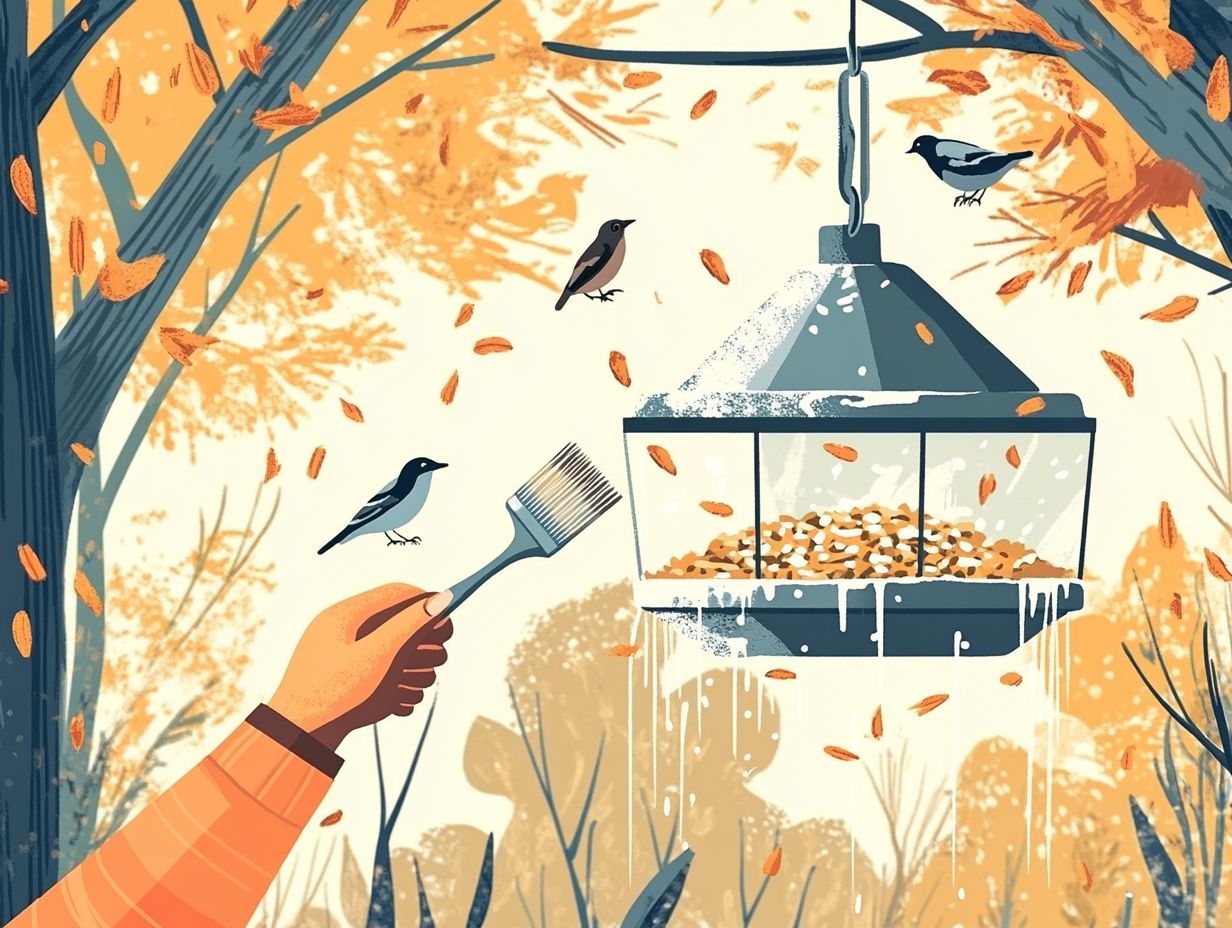
Cleaning your bird feeder regularly helps to maintain the health and safety of the birds that visit it. It also prevents the spread of disease and keeps your feeder in good condition.
What happens if I don’t clean my bird feeder often enough?
If you don’t clean your bird feeder regularly, it can become a breeding ground for bacteria and mold, which can be harmful to birds. It can also cause the feeder to deteriorate and become less effective.
Can I clean my bird feeder too often?
While it is important to clean your bird feeder regularly, cleaning it too often can actually be harmful. This can disrupt the birds’ natural feeding patterns and cause them stress.
How should I clean my bird feeder?
The best way to clean your bird feeder is to wash it with hot water and a mild soap. Make sure to rinse it thoroughly and allow it to dry completely before refilling it with bird seed.
Are there any specific parts of the bird feeder that need extra attention when cleaning?
Yes, the feeding ports and perches are the areas where bacteria and mold tend to accumulate the most. Make sure to clean these areas thoroughly and regularly to maintain the health of your birds.

